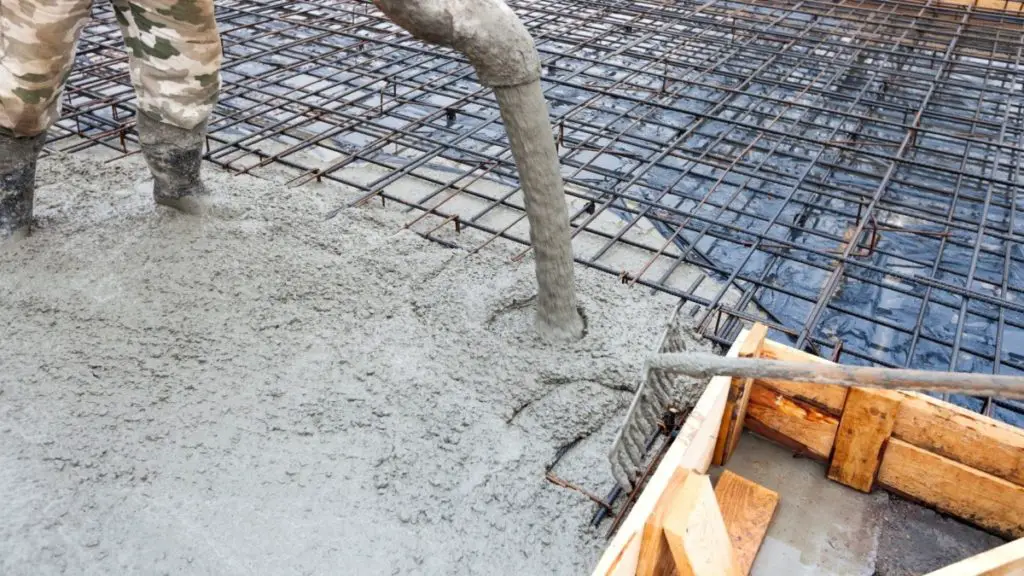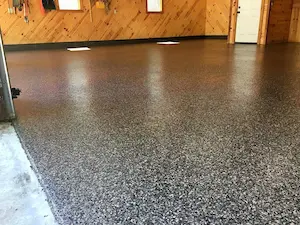Garage Foundations (Types, Requirements & Info)
This post contains affiliate links.
Building a garage is a multi-step project that can take several weeks to complete. But before you construct walls or install a garage roof, you first need to lay a foundation. You’ll also need to choose what type of foundation you’d like for your garage.
The two primary types of garage foundations are concrete slab and basement. Concrete slab garage foundations tend to be the most popular option, especially in areas at or below sea level. You can build concrete slab garage foundations far more quickly than basement foundations.
This guide will explore different types of garage foundations and outline the steps you’ll need to take to build a typical garage foundation. We also take a look at building codes and other requirements for foundations.
Main Types of Garage Foundations
Though home and commercial building foundations vary, garage foundations tend to come in two main styles:
- Concrete slab
- Basement
The right type of garage foundation for your project depends on your preferences, budget, and the elevation of the land you’re working on. Let’s explore all the options to discover which might be the better choice for your garage.
Concrete Slab
Concrete slab garage foundations tend to be the most popular option due to their simplicity, short build time, and affordability. In addition, this type of garage foundation is appropriate for all elevations, unlike basement foundations which can flood if installed at or below sea level.
The average cost to install a concrete slab garage foundation is approximately $4,000. Installing this foundation without outside assistance may lower costs, while adding heated flooring and electrical components can increase costs.
Basement
A basement foundation requires extensive excavation, as you’ll need to dig deeply into the soil to create a basement space beneath your garage floor. You’ll likely need a permit to build a basement, as well as assistance from contractors and electricians.
Consequently, building a basement foundation is costlier than laying a concrete slab foundation. The average cost to install a basement foundation is approximately $40,000. However, prices may be higher depending on the size and complexity of the basement.
Different Types of Concrete Foundations for Garages
Garage foundation is the most important thing that supports the structural integrity of the whole garage. Ground preparation is essential for any foundation. The foundation selection and requirements include garage size, height, and possible frost lines in the area.
4 different concrete foundation types are floating concrete pad, floating concrete foundation, monolithic concrete foundation, and block foundation.
Your options include a gravel pad or a concrete foundation.
Gravel Pad is cost-effective, fast to build, and usually done with gravel surrounded by a treated wood perimeter. They are suitable for carports, small prefab kits, or small modular garages.
Concrete Foundation is required for larger garages and proper support for heavier vehicles. There are 4 different kinds of options for concrete foundations:
- Floating Concrete pad – Simple and cheap. Usually 4” of concrete over 4” to 5” of clean stone.
- Floating Concrete foundation – 4” thick floor with moisture barrier under the concrete and mesh reinforcement and footers up to 12” deep around the perimeter. With optional saw cuts to minimize cracking. Over 4” to 5” of clean stone.
- Monolithic foundation – Similar to the floating foundation with the addition of a frost wall about three or more feet under the pad. And 10″ wide around the pad.
- Block foundation – at least 2 “wide footers are poured at the required frost depth around the perimeter. Concrete blocks are built on top and around the footer. The foundation is completed with a 4” concrete floor.
Build the foundation right to avoid any problems in the long run. You don’t want a ruined garage because of a poorly made foundation.
Bigger foundations for garages are usually best left to professionals.

Building Code Requirements for Garage Foundation
Here are summarized code specifications derived from the International Building Code (IBC) for 1 and 2 story residences. The International Residential Code (IRC) also includes provisions for residential and commercial buildings. The IBC encompasses the IRC.
In the IRC, chapter 4 relates to foundations and footings.
The IBC and IRC are model codes for building structures that communities can adopt and adapt in part as needed. Code rules are enforced at the local level. So always check everything from the local building department or similar entity.
Site Grading
The exterior of the foundation (the ground immediately adjacent to the foundation footings )should slope down at a 5 % minimum slope for at least 10 feet.
Load Bearing Value of Soil
Foundations must rest on undisturbed soil. Undisturbed soil means soil that has never been turned over, compacted, dug, scraped, tilled, graded, amended, or anything similar of that nature by machine or man.
Undisturbed soil is much stronger than soil that has been disturbed.
A disturbed soul can be classified as undisturbed after enough time has passed. But only a soil test can determine that.
The code refers to load-bearing values (LBV), so a soil test is needed to know the LBV of the soil for the site.
| Soil Type | LBV Per Square Foot |
|---|---|
| Bedrock | 12,000 |
| Sedimentary Rock | 4,000 |
| Sandy Gravel or Gravel | 3,000 |
| Sand, Silty Sand, Clayey Sand, Silty Gravel, Clayey Gravel | 2,000 |
| Clay, Sandy Clay, Silty Clay, Clayey Silt | 1,500 |
Depth, Width, and Thickness of Footings
Depth of Footings
Footings should extend to at least 12 inches below previously undisturbed soil. Footings need to extend at least 12 inches below the frost line. This may not apply to accessory buildings like sheds.
Width of Footings
The width of footings will vary according to the site, soil, local conditions, and structure size. Generally, one-story buildings should have a minimum width of 12 inches footings under the soil with LBV between 1,500-4,000
Levelness of Footings
Levelness requirements of the footings are different for the top and bottom of the footings.
Top of the Footings
The top of the footings must be level in all cases.
Bottom of the Footings
Preference is level for the bottom of the footing. Still, if you are building on a sloped grade, you can step the footings 1 unit vertical per 10 units horizontal.
Spread of Footings
The load carried by the footings distributes over to a broader area with spread footings. The spread footing should be no less than 6 inches thick and project at least 2 inches on both sides. Preferably more.
How Thick Should Slab Be for the Garage?
The standard is expressed in compressive strength. 4 inches is the minimum thickness required in many areas. The slab needs to be thicker than 4 inches for heavy equipment such as RVs and trucks. Building codes usually have requirements for the concrete mix, which vary by region.
The concrete slab’s minimum thickness is 4 inches usually. The minimum strength of the concrete should be 3,500 PSI for garages. Vertical walls exposed to the weather may be required to have 2,500 PSI minimum strength for concrete or up to 3,000 PSI for severe local weather conditions.
Compressive strength is also a pound per square inch (PSI) (the pressure resulting from a force of one pound-force applied to an area of one square inch)
You can order the concrete for any desired PSI value. The compressive strength usually varies from 2,500 to 4,000 PSI and higher for residential structures.
PSI comes down to the amount of water used in the concrete mix and the thickness of the slab. Adding too much water makes the pouring easier but makes the slab weaker. Instead of water, plasticizers can create a more effortless flowing mix without compromising the compressive strength.
Do You Need a Rebar in a Garage Slab?
Concrete slabs usually need reinforcement, or they will not last long. In many areas reinforcing of the concrete slabs is not required. But it’s recommended to prevent cracks and shifting. The slab needs to be reinforced and thick enough if you plan to park heavy vehicles like RVs, trucks, or other heavy equipment.
Rebar (short for reinforcing bar), wire mesh, or newer option fiber are important for concrete foundations. Concrete is strong under compression but has weak tensile strength. So reinforcement is needed. Rebar significantly increases the concrete slab strength and durability.
Fiber reinforcement matches well to wire mesh and has become popular in recent years. Fibers are mixed into the concrete to increase the structural strength of the foundation.
Does a Garage Foundation Need Footings?
The need for footings depends on the type of foundation, Planned building type, and soil quality. Footings may be required by the local building code.
Footings support the foundation of the garage and keep it from settling unevenly. Basic structures are not required to have footings unless the area has poor soil conditions, Freeze-thaw, or the lot slopes. Not all foundation types have footings. Like a simple gravel pad or floating concrete pad.
The soil also needs to be compact enough for the foundation type planned. You need to know the load-bearing value of the soil.
Garage Foundation Footing Benefits
- Supports the walls – The walls put the most weight on the soil and foundation. Footings help distribute and support that weight. Footings also keep the structure from sinking.
- Problematic Soil – Soil can be problematic and shift in some areas. Footing prevents problems with the foundation.
- Cold Weather Climates – If you live in cold areas where freeze occurs every year. The freeze/thaw cycle will lead to the soil shifting and unsettling of the foundation. Footing that goes below the frost line stops that from happening.
- Stable Foundation – Footings keep the concrete slab from settling and prevent cracks and other typical concrete slab problems.
- Even Settling – Some settling always occurs in the soil. The footing will keep the garage settling unevenly.
Type of Garages That Require Footing
- Garages with second floor or similar building type.
- Garages built on a slope greater than 10 degrees.
- Any area where local building codes require footings.
- Attached Garages.
The footings are usually 20 inches wide and 8-12 inches deep. Garage footers also need to reach under the local area frostline.
This can vary by state or municipality, so always check local building codes and requirements before starting the planning or actual work. Remember the building permits also.
How Many Bags of Concrete Do I Need for a Slab?
Concrete slab volume is calculated by multiplying the slab’s length, width, and depth.
The weight of concrete is determined by its density, which can vary based on the amount of aggregate, water, and air in the mixture.
1 cubic yard is the unit of volume measurement represented by 3 feet long by 3 feet wide by 3 feet depth (3’×3’×3′ = 27 cubic feet), so 1 cubic yard is equal to 27 cubic feet.
| Size | Thickness | Cubic Yards | #Bags | Bag Weight |
|---|---|---|---|---|
| 10X10 | 4 | 1.25 | 56 | 80 LB |
| 10X10 | 5 | 1.6 | 72 | 80 LB |
| 10X10 | 6 | 1.85 | 84 | 80 LB |
| 10X10 | 7 | 2.2 | 99 | 80 LB |
| 10X10 | 8 | 2.5 | 113 | 80 LB |
Dry mix concrete bags are available at different weights. Such as 40-90 LB
Here are some calculators, so you get a good estimation and don’t buy too many bags.
Concrete Calculator – How Much Do I Need? | QUIKRETE: Cement and Concrete Products
Concrete Calculator – How Much Concrete Do You Need? – Inch Calculator
Garage Foundation Drains and Heating
When constructing the foundation, it’s easiest to add drains, pipes, and possible radiant heating within the floor simultaneously before pouring the concrete. Both are hard to add later and require cutting into the concrete. Simple trench drains are easy to install in front of the garage afterward but also require cutting.
Radiant heating is ideal for workshops as it provides heat with no moving air. Keeping the space dust and particle free. Radiant heating emanates from the floor.
Read more about garage heaters here.
Proper drains in the right places make cleaning the floor so much easier and keep the garage moisture-free. Installing filters with the drain allow also separating oil and other harmful substances from the water.
Read all about garage drains here.
How To Build a Garage Foundation
Building a garage foundation can be challenging, especially if you plan to construct a multi-car garage or workshop garage. Still, all garage foundation projects consist of two essential steps:
Choose a Garage Foundation Type
Before you can build a garage foundation, you’ll need to choose a foundation type.
If you live in a higher elevation area and want to add more living space to your home, you may want to choose a basement foundation for your garage. However, if you’re determined to keep costs low and live in a lower elevation area, a cement slab foundation is likely the better option.
After deciding what type of foundation you’d like for your garage, you’ll need to choose between a DIY and professional installation.
Decide Between a DIY and Professional Installation
Depending on your preferences and budget, you’ll want to either build garage foundations without a contractor’s help or hire a team to construct a foundation on your behalf.
Naturally, a DIY garage foundation project will incur lower costs. But you will need to spend several days preparing the foundation site, digging trenches, and pouring concrete. So, hiring a contractor may be the better choice if you don’t have the time to devote yourself to the project.
Still, pouring a simple slab foundation is a relatively straightforward process. There are rules and regulations that need to be accounted for.
How To Pour a Slab Garage Foundation
Those opting to build a slab garage foundation themselves will need to follow several steps to get the job done.
Let’s delve into these steps to ensure that your slab concrete foundation project goes smoothly:
Gather Foundation Materials and Tools
The first step of any slab concrete garage foundation project is gathering your materials and tools. You’ll need several materials, including:
- Concrete
- Gravel
- Plywood panels
- Steel rebar sheets
- Rebar stakes
You’ll also want to ensure that you have essential tools for the project, including:
- Hammer
- Cement mixer
- Shovel
- Wheelbarrow
- Level
- Tape measure
Clear the Foundation Location
Before pouring the concrete to form your garage foundation, you’ll need to prepare the site. First, remove any plants, objects, or debris from the site until you have a level area of soil. After that, you can begin digging the foundation trenches.
Dig the Garage Foundation Trenches
Naturally, you’ll want to measure and mark the perimeter of your slab foundation before digging trenches. Ensure that all foundation corners feature a 90° angle and draw your lines using spray paint, lime, or wooden posts with strings tied between them.
You can then dig trenches along these lines. You’ll want these trenches to be about 1ft (0.31m) wide and 2ft (0.61m) deep. The bottoms of these trenches should be flat and level.
Pour Gravel or Concrete Into the Foundation Trenches
When you’ve finished digging the trenches, pour 2 inches (5.1 centimeters) of gravel into the channels. You’ll need to level this gravel layer before building and installing form boards along the foundation perimeter.
Build and Place Form Boards Along the Foundation Border
Wooden form boards hold the concrete in place during the curing process. As such, they’re an essential part of building a slab garage foundation. Secure the form boards with large nails and place small wooden slats along the outside to keep them supported.
Lay a Steel Mesh Sheet Above the Soil Foundation
Now you can lay a rebar sheet above the soil foundation.
This extra layer of material will add strength to the final slab floor. It can also act as a placement guide during the pouring process.
Mix and Spread Concrete Over the Steel Sheet
When your rebar sheet is level and secure, it’s time to mix and pour the concrete. Be sure to follow the manufacturer directions listed on the cement bags to ensure the mixture is the proper consistency. Use a cement mixer to produce large quantities of cement simultaneously.
When the cement is adequately mixed, pour it onto the rebar sheet. Start at one corner and slowly work outward toward the opposite corner. Ensure that the concrete flows into the perimeter trenches and level it with a flat-edged wood board (screed board).
Garage Foundation and Concrete Slab Cost
If you want the job done by professionals, Here is up-to-date info at Homeadvisor.com and Homeguide.com
https://www.homeadvisor.com/cost/foundations/install-a-foundation/
https://homeguide.com/costs/foundation-cost
https://www.homeadvisor.com/cost/outdoor-living/concrete-slab/
https://homeguide.com/costs/concrete-slab-cost
Final Thoughts
The two most common types of garage foundations are concrete slab foundations and basement foundations. Still, concrete slab garage foundations tend to be more popular due to their reduced excavation needs and faster build times.
To pour a slab garage foundation, you’ll need to clear the foundation area, dig trenches along the sides, and ensure the pre-foundation soil is level. Next, place rebar mesh to add strength to the concrete.
After that, mix, pour, and level as you fill the perimeter. Wait for the concrete to dry before removing the boards from the foundation sides.
After your new concrete floor is constructed. Check your different options for finishing the floor here.
Sources
- HomeAdvisor: How Much Does A Concrete Slab Cost?
- 2022 Cost to Pour a Concrete Slab Cost Per Square Foot (homeadvisor.com)
- 2022 Concrete Slab Costs | Cost To Pour (Per Square Foot + Per Yard) (homeguide.com)
- The Spruce: House Foundation Types, Uses, and Pros and Cons
- Family Handyman: How to Form and Pour a Concrete Slab
- Concrete Foundations for Garages and Sheds | Site Preparations LLC
- 2022 Cost To Build A Garage | 1, 2, and 3 Car Prices Per Square Foot (homeguide.com)






